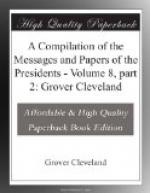The second clause in which the words occur is as follows: “Ad stationem navium Sanctae Mariae vulgo St. Marys Bay, et deinceps versus septentrionem per directam lineam introitum sive ostium magnae illius stationis navium trajicientem,” etc., “ad fluvium vulgo nomine Sanctae Crucis appellatum.” Here the line, although directed to be drawn toward the north, is also directed to be drawn between two given points, and it is clear that under the double direction, if they should differ from each other, the position of the given points must govern, and the line be traced from one of them to the other, no matter what may be their bearings.
The last time the words occur is after the direction that the line shall pass up the St. Croix and to the most remote western spring or fountain of that stream, “unde per imaginariam lineam directam quae pergere per terram seu currere versus septentrionem concipietur.” Here alone can any doubt exist as to the meaning of the terms, and that is easily solved.
The boundary pointed out in the instrument is “such as may be conceived to go or run toward the north by (per) a direct (directam) line.” Now a direct line toward the north can be no other than a meridian line. Had it been merely a straight line of vague northerly direction which was meant, rectum, the usual expression for a mathematical straight line, would have been used instead of directam. It is, moreover, to be considered that the Romans had names both for the northeast and northwest points of the compass, and that the expression “versus septentrionem” in its most vague application could not possibly have admitted of a deviation of more than two points on either hand. Had the direction intended deviated more than that amount from the true north, the Latin term corresponding to northeast or northwest must have been used. Nor is this a matter of mere surmise, for in a passage immediately following that which has been quoted the direction through the Gulf of St. Lawrence toward Cape Breton is denoted by the term “versus Euronotum,” leaving no possibility of doubt that had the line directed to be drawn from the source of the St. Croix been intended to have a northwestern bearing the appropriate Latin words would have been employed.
It is, besides, to be recollected that the instrument was drawn by a person using habitually and thinking in a modern idiom, and that in translating the English words due north into Latin no other possible expression could suggest itself than the one employed. Such, then, was the sense appropriately given to the Latin words, first in the commission of Governor Wilmot and his successors, governors of Nova Scotia, and subsequently in the commission of all the governors of New Brunswick from the time that it was erected into a province until the question was referred to the King of the Netherlands. In this reference, although a translation was given in the American argument, it was not as quoted by Messrs. Featherstonhaugh and Mudge, but was in the words which have already been cited.




